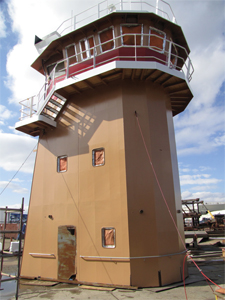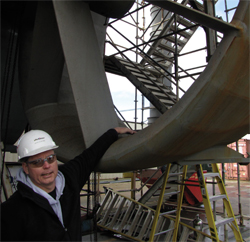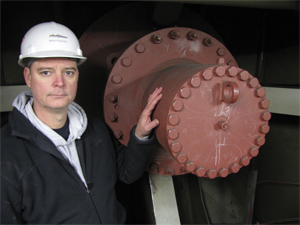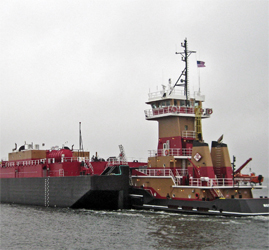The simple need to push smaller fuel barges with a different coupling system has prompted Reinauer Transportation to design a whole new class of tugboat.
Until recently the articulated tug-barges (ATBs) built for the company had been equipped with couplers from Intercontinental Engineering. This year, the company, which is based in Staten Island, N.Y., is rolling out a new series of three 115-foot tugs that connect to their barges with JAK coupling systems. That means the new Franklin class tugs — starting with the 4,000-hp B Franklin Reinauer — have a slightly narrower beam than the previous Ruth class. The deck layout is totally different.
“It’s a completely new design,” said Chris Reinauer, the company’s manager of new construction. “We needed to fit a new barge class. Everything we do is for maximum efficiency.”
Concerned about sacrificing storage and work space, Reinauer opted for a full-length-forecastle design for the new vessels.
“Instead of a deckhouse, we have this fully enclosed volume that’s almost the length of the boat and is the beam of the boat,” said designer Robert Hill, president of Ocean Tug & Barge Engineering Corp. “It gives you much more space inside.”
 |
|
Dom Yanchunas |
|
B Franklin’s pilothouse at the Senesco Marine yard, before it was finished and installed. |
The Ruth class boats, including the recently launched Reinauer Twins, use Intercon couplers to push their large barges — either 413-footers with a capacity of 100,000 barrels or 347-footers that can carry up to 80,000 barrels.
B Franklin Reinauer and its two sister boats will push 347-foot barges with an 80,000-barrel capacity or 311-footers with a 60,000-barrels capacity. Both classes of barge have narrower notches for the JAK couplers.
Like the Ruth class, the Franklin class has MTU 4000 series engines.
“It’s a slightly smaller beam and slightly shorter, but with an identical propulsion system,” Reinauer said. “We were the prototype test for the 4000 series, so we know them better than anyone. We’re pretty comfortable with them.”
The 4,000-hp Franklin class will replace 3,000-hp boats that were built in the 1970s and 1980s. When the Franklin class is fully in trade, it will have boosted the Reinauer fleet’s average speed to 9 to 10 knots from the previous 8 to 9 knots. The company operates 20 tugs and 22 barges, which move fuel up and down the East Coast, usually between Maine and Maryland. B Franklin Reinauer also will be SOLAS-compliant to make it eligible for international voyages.
“We’re now being more speed-conscious,” Reinauer said. “With more horsepower, we’ll make better speed as a fleet.”
The Ruth class impressed the engineers with its power, reaching 14.3 knots during sea trials and pushing loads at 10.3 knots. “Our tested bollard (pull) was about 20 percent more than we expected,” Reinauer said. “We have high-speed engines. I don’t believe in using 100 percent of their power 100 percent of the time. We let them breathe a little easier.”
Reinauer expects the operating speed of the sleeker Franklin class to be 12 knots.
B Franklin Reinauer is fitted with three independent high-aspect-ratio rudders, for increased maneuverability. The system boasts deep-reduction gears, stainless-steel pre-swirl stators and curved Kort nozzles that reduce drag.
 |
|
Dom Yanchunas |
|
Michael Foster, vice president and general manager of Senesco Marine, points out the curved surface of one of the Kort nozzles designed to reduce drag and boost the thrust of the propellers. |
“The reverse curvature generates the lift, which translates into a few percent more thrust,” Hill said.
The pre-swirl stators help because “as the water is pulled into the nozzle by the propeller, they get it so the water is swirling in the opposite direction of the propeller, which gives the propeller more bite,” he said.
Because of the high-aspect-ratio rudder systems, the maneuverability of the Reinauer tugs sometimes makes the crews feel they are in a z-drive.
“They can almost turn in their own length, which is pretty good for a conventionally propped boat,” Reinauer said.
The Franklin class has a beam of 32 feet, and the 60,000-barrel barges are 68 feet wide, versus the 74-foot width of the 100,000-barrel barges.
“They fit into a smaller notch than the Ruth class does, so we were restricted in the width of the boat,” Hill said. “Behind a barge, they’re every bit as fast and every bit as fuel-efficient as anything they have.”
The so-called “forecastle tug” allows the designers to build a smaller vessel without sacrificing roominess.
“The forecastle deck gives you a huge interior (allowing for) bigger staterooms and a lot more space for storing things and for the emergency generators,” Reinauer said.
The design has the added benefit of enhancing vessel stability, Hill said.
“The full-length forecastle gives you a lot of righting energy,” he said. “When you heel, the deck edge doesn’t go under water. We’ve added extra structure in the bottom to lower the center of gravity.”
The Ruth class was Senesco’s first that used Hill’s novel “facet tug” concept in which the hull is constructed in segments of flat plate instead of curved or “formed” plate. Using flat steel saves money and construction time, and the Franklin class uses the same design.
“We all sat down and said, ‘What can we do with straight plate instead of rolled plate?’ There’s really no rounded corners on the thing. It’s all sheer,” said Michael Foster, vice president and general manager of Senesco Marine, the yard that is building the boats. “Once you put it in the water, it looks just like a regular tugboat. When you look under the water, it just sticks out how different it is from anything out there.”
 |
|
Dom Yanchunas |
|
Senesco’s Michael Foster with one of the pins of the JAK coupler system that will link the tug to either of two classes of barges: 347-footers with an 80,000-barrel capacity or 311-footers with a capacity of 60,000 barrels. Both classes of barge have narrower notches than previous Reinauer barges, and this new tug was designed to fit into the smaller notch. |
Another money — and weight — saver in the Franklin class is the single-skinned fuel tanks. The Ruth class had double-skinned tanks because the owners originally expected the boats to work in an environmentally sensitive area in Florida.
One area in which Reinauer does not like to skimp is comfort. With a work schedule of three weeks on, three weeks off, the crews live on the boat for weeks at a time. Hill takes pride in designing the wheelhouse, workspaces and crew quarters with the crewmembers’ preferences in mind. Foster notes that the Franklin class compartments are coated with Delta T paint, which insulates against sound and even heat.
“It’s a sound-deadening paint, and the insulated wallboard really creates a sound barrier,” Foster said. “They’re quiet boats. The owner expects a superior vessel, and it’s a great selling point for them. They don’t mind spending a little extra to make that happen.”

